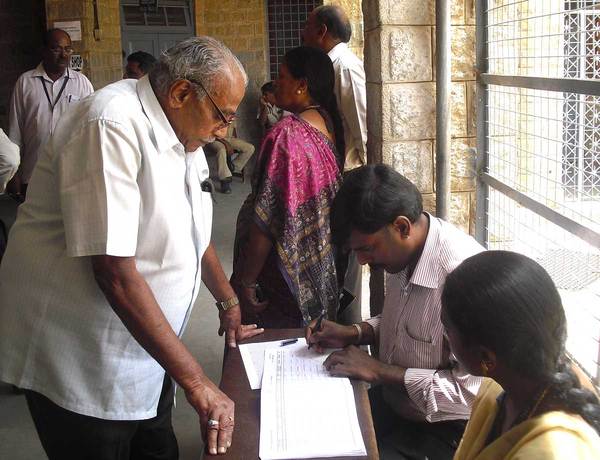Election is the mechanism to form a government by the people. Every person ruled by such government should have participated in the elections to make it truly a government by the people.
Under Article 326 of the constitution, every Indian citizen above the age 18 years can register as a voter. We do not discriminate based on sex, race and religion. However, only the citizens whose names appear in the electoral roll have the right to vote.

Citizen casting his vote. Pic: Sankar C G
Election Commission of India states that about 61 percent of the population would be above 18. Of this population, it is a fair guess that at least 10 percent are not registered as voters. Therefore, at best, government by the people is by less than 50 percent of the people in the country. What percent of this 50 percent participate in the election process is a subject of debate at different spheres, heating up during election period and cooling off with inaction soon.
Voter Turnout is the percentage of eligible voters who participate in an election. We rank 36th in voter turnout among 39 democratic countries surveyed and reported in Wikipedia.
In the 2009 Parliamentary Elections, national average of voter turnout was 59.19 percent. The average turnout in 15 elections since independence is 59.18 percent – the lowest being 55.25 percent in 1971 and highest at 63.75 percent in 1957.
Chief Election Officer (CEO), Karnataka reported average voter turnout of 64.87 percent in Assembly Elections, Karnataka, 2008; news reports say that it was 61 percent. In that election, polling in 27 constituencies of Bangalore City was 46.88 percent. Turnout in BBMP Elections, 2010, was 45 percent. The voters in BBMP Elections are the same as in the Assembly Elections in these 28 constituencies.
Voter turnout is higher in rural India, which is not limited to Karnataka. Though we repeatedly hear that larger percentage of educated urban middle class people do not participate in elections, the hypothesis was not proven in BBMP Elections 2010. Voter turnout study in that election does not show in difference in voter participation based on education of economic class.
Low voter turnout creates doubt about legitimacy of the elected government and democratic system, which is not good for democracy. We cannot form a truly ‘government of the people’ if citizens do not participate in choosing their representatives.
But voter turnout is based on the voters in electoral roll. When the quality and completeness of electoral roll is suspect, the inferences and calculations based on that can mislead. Actions based on these inferences can create new problems.
We have enough evidence to prove that the electoral rolls of 28 constituencies of Bangalore City are dismal in terms of data quality and data completeness. The voter lists exclude large number of eligible voters and include large number of duplicate and illegitimate entries. Therefore, to tag the voter turnout with a number in Bangalore City is wrong.
In the next few sections we shall discuss some realities of election processes in Karnataka and suggest actions by the citizens to improve the situation to make elections by the people a reality.⊕